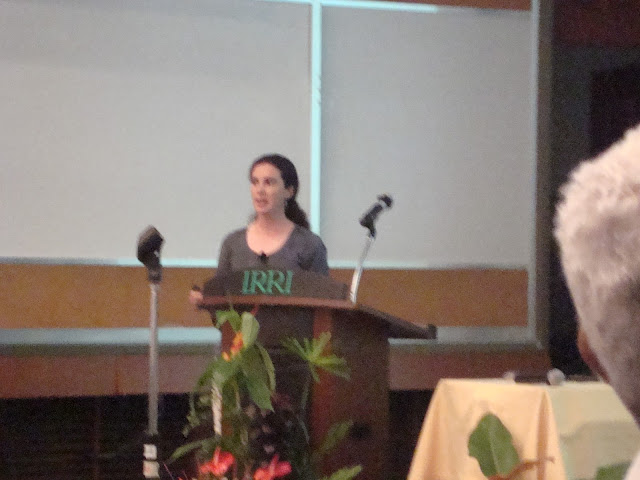I agree with you all that we had an exciting week with the GRiSP annual review. We had serious time twitting from event hall. More senses were alert than usual. We had to listen keenly, paraphrase clearly, type correctly, and most importantly tweet before anyone else. Catharsis was higher than in a competition. First half of the first day I was lost. I could not understand the speakers completely. And I judged myself several times if I was wasting my time doing things other than listening. In the afternoon I recovered. Since second day, I realized I was using more parts of my brain more efficiently than ever before. It was a good brain-training for me.
At times I felt it was just the twitters who were aware of the online twitting. Later, I realized many people were aware that real time twitting and blogging was going on. May be they did not want to show online presence. That inspired me. When I saw you with phones, laptops and camera, I felt I was not an exception in the room.
Were you benefited?
I was most benefited on first two days when there were concurrent sessions and online feeds by the live bloggers from other room were easy to catch and get updated. I did not miss the other events- the concurrent ones especially.
On the underprivileged segment of what's defined as the world's poor, isn't it that rice quantity comes first before quality? #GRiSP2012
In South America, breeders aim for 55% head rice yield. Its definition here:http://www.knowledgebank.irri.org/postproductioncourse/Additional/MilledRice/head_rice_definition.htm …. #GRISP2012
"We should talk about SHAREholders, instead of stakeholders" -Mr Moderator quotes AfricaRice DG. #GRISP2012
as @rochiecuevas puts it in her blog entry, rice science is in good hands with these awesome, young scientists involved in #GRISP2012
RT @adamhsparks Rice knowledge bank is huge resource, well validated by IRRI, but only 23% return users. http://ow.ly/eiagS #grisp2012
IR64 was Tungro resistant when released, due to GLH resistance, has broken down. -IR Choi #plantdisease #rice
My blog post for today: Spotlight falls on young (or early-career) scientists#GRISP2012 | http://rochiecuevas.blogspot.com/2012/10/spotlight-falls-on-young-or-early.html?spref=tw …
Acquiring the DNA fingerprints of rice varieties will avoid non-useful crosses. -Eero Nissila on GRiSP2012 #GRiSP2012
"Partnerships take time to develop. It has to be a win-win situation and must have blending." - Noel Magor reviews the GRiSP T6. #GRiSP2012
There is negative effect from heat stress on panicle meristem development. - Sigid Heuer #GRiSP2012
Tri-center collaboration between IRRI, CIAT, and IWMI being explored in Laos. -Ben Samson #grisp2012
RT @buruguduy: Philippine gov't is promoting food diversification as part of its goal to attain rice self-sufficiency. #grisp2012
Ayus a, cant go to on-going #GRiSP2012 but am appreciating to@rochiecuevas at @buruguduy 's efforts. Kaya nyo yan!
Final wrap-up session. Overviews of rice res for Africa, Latin America, Asia and all res by France and Japan. Info overload! #GRISP2012
If intellectual property rights (IPR) and information right (IR) meet anywhere, it was in our blogging and twitting. Most of us talk about IPR, and have developed a sort of fear and an assurance that there is a system. But we don't see any presence of regulating bodies either campaigning awareness nor disciplining. There has been no remarkable case worth an example of IPR issue. But we cannot expect this static situation for good. Now I feel, we should intentionally tweet more sensitive results: to get attention of the people who should caution and be cautious of the IPR issues. Even if we get into trouble, we can come out quite easily because, we can turn off our accounts and set our blogs to private views only. By this we offer hot news and events, and prick every one's ears to be cautious.
Now we are one step ahead in this field of real time twitting. Is it possible to find one protegee each to transfer the knowledge gained and increase the circle of like minded enthusiasts of twitter generation.
Thanks
On Tue, Oct 16, 2012 at 9:09 AM, Cindy Llorente wrote:
I'm sharing the same sentiments as well.
We definitely enjoyed the experience. Salamat ng marami din! :)
We definitely enjoyed the experience. Salamat ng marami din! :)
On Tue, Oct 16, 2012 at 9:05 AM, Manuel Marcaida wrote:
The pleasure's all mine. Thanks for the opportunity. It was a good time of learning and sharing, and a fun listening exercise too. :)
Looking forward to participating again in another IRRI event.
Cheers,
Man
On Mon, Oct 15, 2012 at 4:30 PM, Sophie Clayton wrote:
Dear all,
I just wanted to drop you a line to say a super big thanks for your tweeting efforts during the GRiSP week. You successfully engaged some external participants and encouraged a few other local participants to tweet and engage too.
We are hoping to run some analytics on the IRRI web site to see if it affected traffic to irri.org at all. However, the main point was to generate a conversation and encourage followers. I had some positive feedback which suggested people enjoyed your tweets and found them easier to follow than the full presentations because you did the hard work in distilling the information into something short and easy to understand. So congratulations - I hope we can have an even bigger crew, and promote it more at the youth science conference.
Regards,
Sophie


















































